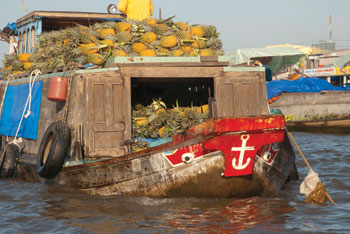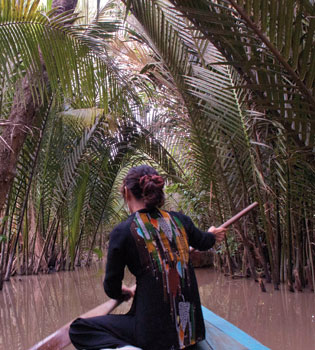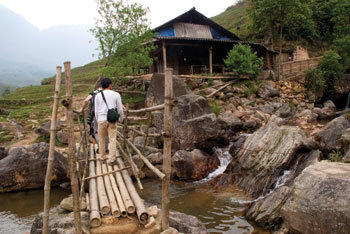 I didn’t know what to expect from my visit to Vietnam. As an American would I be the object of animosity because of America’s frightful presence here in the 1960s and 70s?
I didn’t know what to expect from my visit to Vietnam. As an American would I be the object of animosity because of America’s frightful presence here in the 1960s and 70s?
Not at all, it turns out. Most Vietnamese were born after 1975 or are too young to remember the war, while the attitude of the older generation appears to be that the past is best put aside.
Still, reminders of the war are plentiful. On a sidewalk in Hue I encountered a man selling objects that had belonged to U.S. servicemen: inscribed cigarette lighters, in-signia, and clothing.
In the “Hanoi Hilton,” the former French prison that had at one time held as many as 100 U.S. POWs, I saw the flight suit and parachute worn by Senator John McCain when he was shot down.
Saigon’s War Remnants Museum tells the story of the American War in ways that are both moving and troubling. The museum’s forecourt is filled with examples of Amer-ica’s war machinery. Some of it amazed me; I never knew just how big a Chinook helicopter is. Inside, most of the e
xhibits are photographs, some documenting anti-war protests around the world, including those in the U.S.
For me, old enough to remember how torn apart our country was by the draft and the antiwar movement, the memories came flooding back. America lost more than 50,000 lives in the war, while the Vietnamese lost more than one million. The rooms filled with photos shot by some of the world’s bravest photojournalists are powerful, and those documenting the effects of Agent Orange and other chemicals on the civilian population are all too graphic. Of course, the story of the My Lai massacre is given prominence.
No one walks in Vietnam; everyone rides something.
Most people get around on motorbikes. There is no metro in Hanoi, and buses aren’t plentiful, yet some form of wheeled transportation is necessary because Vietnamese cities are not for walkers. The heat and humidity are against it, and the sidewalks are an obstacle course of parked motorbikes and people cooking and eating. It’s said that Hanoi has six million people and four million motorbikes. When a pack of 50 of the latter accelerates from a traffic light, the effect is what you could expect if you upset a hornet’s nest.
The flow of motorbike traffic can be unceasing. To cross a street in a Vietnamese city, you walk very slowly into the traffic stream, and somehow the bikes adjust and swirl around you. The trick is to not panic. It takes nerve, and I wouldn’t try it in New York or Istanbul. Whole families ride on a single motorbike. Dad drives with junior curled like a pretzel at his feet. Sis rides sandwiched between her father and mother, who rides at the rear.
For me, just as in China, the motorbike taxis are welcome. There was almost always someone ready to give me a lift for a reasonable fare. I long ago lost count of how many times I rode somewhere on the back of a motorbike.
Some of my liveliest conversations took place with the hill-tribe women—the Black Hmong and the Red Dzao—in the far north of the country near the Chinese border. I had gone to Sapa, a town built in the 1920s by the French as a hill station, on a night train from Hanoi in order to trek for a couple
days. Nowadays, the town is tourist central, with hotels and restaurants of every class. Each day dozens of women wearing their distinctive tribal dress roam the town selling their handicrafts. These are hardy women, as I was to discover on my short but intense trek. They have had little or no formal education, yet some of them have picked up a lot of English. They seemed to understand me better than the lowlanders I was having trouble with in Hanoi. Talking with them was fun, but not a casual interaction. They were out to sell what they had and believed that after the final “no” there would be a “yes.”
My trekking experience lasted two days with an overnight homestay. The trekking itself could have been better. Although it was wonderful to look down the valley at the terraced rice paddies and walk through little villages with their traditional ways, the weather was rainy and the steep hillsides were treacherously slippery.

My guide for this particular adventure was Chili, a local man, very strong and fit, who did a good
job of looking out for me. However, his English had a serious pronunciation deficit. It took me several tries to understand his mangling of “hydroelectric.”
On both days Chili and I walked, we were shadowed by a different tribal woman, who would keep close to me and offer me her hand when i
t looked as if I were about to take a pratfall. I was surprised by how strong a grip these women had. Of course, I was grateful for the assistance, and it finally dawned on me their helpful presence was also a bonding strategy. When it came time to part at some village, I would buy a souvenir.
The glory of Vietnam is its cuisine. Whether in a hole-in-the-wall or a fancy-pants restaurant, it seemed impossible to have a bad meal. Some of my most memorable were at street kitchens, where I would be offered a bowl of steamed rice topped with some vegetables and a small piece of pork, beef, or fish. With some chili sauce on the side, these meals that cost less than $2 were always delicious.
I took a cooking class in Hanoi, in part just to discover the secrets of the flavoring. Partly it’s the intense bottled fish sauce sold in every market. I learned how to tell the best kind by its clarity and by the words Mam Nhal, meaning first extraction, on the label.
Another important principle in Vietnamese cooking is the inclusion and blending of five flavors: sweet, salty, sour, bitter, and spicy. It’s been fun learning to identify the sources of these tastes in Vi
etnamese cuisine.
I wish there were more restaurants like Hanoi’s Cha Ca La Vong—places that serve only one dish and do it superbly. As I walked in, a man on the other side of the room held up two fingers, and I held up one. He pointed to a staircase. Upstairs
I sat at a vacant table and looked around the crowded room: fluorescent lighting and walls of a green color I’d never seen in nature. After a short wait, someone deposited a laminated card in front of me. In English it read:
Only One Dish in Our Restaurant
Grilled Fish
150,000 VND/Person
Not Included drink
Next came a bowl of greens, including some dill, and julienned leeks; a bowl of steamed rice and another of cold, cooked noodles; small bowls of chili oil, and peanuts. Finally, a bowl of cilantro sprigs and a bitter herb I couldn’t identify.
Then came the pièce de résistance: in a small frying pan on a flaming burner were a dozen nuggets of cooked fish sizzling in hot, seasoned oil. A woman server pointed to the greens and motioned for me to add them to the oil. I did as I was told and stirred them with my chopsticks. Then I removed them and some fish to my bowl on top of some rice. I topped these with cilantro, peanuts and chili oil. It was delicious. The combination of these simple ingredients mixed with the seasoned oil from the frying pan was excellent. I repeated the process until I had eaten everything. The cost for the meal, including a bottle of beer, was less than $10.
I left without having spoken a single word to anyone.
The Mekong is
one of the world’s great rivers, rising in Tibet and flowing through Laos and Cambodia before spreading out into a huge maze of canals in the far south of Vietnam. On my first day in the Mekong Delta town of My Tho (which has its own version of the country’s delicious noodle soup), I connected with a woman named Yen who said she was a guide and had her own motorbike. She borrowed another from a friend for me, and away we went.
Yen didn’t speak as much English as I had expected and didn’t know some of the roads much better than I did, but she could ask directions and understand the replies. She found the back roads I wanted to travel. I couldn’t have done the trip with-out her.
These back roads aren’t roads at all, but rather concrete slabs only about a meter wide. Some were not in good shape and had to be negotiated carefully. We crossed many humpbacked bridges over canals and stopped while I photographed sights along the way. It was a perfect way to see this part of the country. We stopped in settlements of only four or five dwellings where the residents claimed no tourist had ever been before.
On our last day, I hired a boat and went up the Mekong River. For those of us old enough to remember the war, such a trip might conjure images of American patrol boats or Francis Ford Coppola’s Apocalypse Now. But mine was a small boat, and we were traveling upriver to see the locally famous floating market. We arrived as the market was going full tilt, with dozens of boats large and small jostling with each other to buy and sell. This is a produce market, and each boat is equipped with a tall pole to which samples of certain fruits and vegetables are tied. This method allows buyers and sellers to find each other. It was an active and colorful scene, one I’m very pleased to have witnessed.
Eric Farber and his wife, Kay, live in Istanbul, Turkey, and keep friends apprised of their world travels via email. “A Taste
of Vietnam” is excerpted and edited from one those messages.
Contact Eric at ericfarbernyc@yahoo.com
 I didn’t know what to expect from my visit to Vietnam. As an American would I be the object of animosity because of America’s frightful presence here in the 1960s and 70s?
I didn’t know what to expect from my visit to Vietnam. As an American would I be the object of animosity because of America’s frightful presence here in the 1960s and 70s? 
